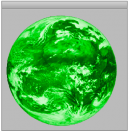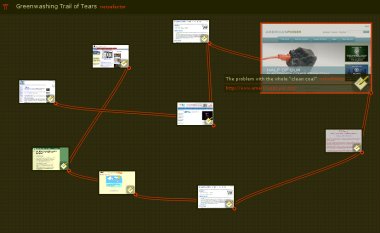
The 2011 prize for Interactive Digital Art of Extremadura University has been awarded to New York artist Andy Deck. [More]
This image pictures a scarf produced by We Are in London. Appropriation is a mercurial thing. There have been many images of Glyphiti published in…
Why "Earth Art for the 21st Century"? Like a lot of people, the artists who formed Transnational Temps in 2001 (info about the collective follows this article) sensed that coverage of global warming and other environmental issues was woefully inadequate. Commercially sponsored "informative" programming continues to suffer from attention deficit disorders, to say nothing of conflicts of interest. The Internet has presented a means to address the situation.
Originally by deck from deck’s blog on May 14, 2008, 2:48pm

Nell Tenhaaf summarizes the best the VIDA competition, including an early work from Transnational Temps.
From Spain, Novus Extinctus (2001, VIDA 4.0) by Transnational Temps (Andy Deck, Fred Adam and Verónica Perales), is an Internet artwork whose central message is that the expansion of human presence on the World Wide Web, measured via the number of domain names registered daily, climbs in a deadly parallel with the number of species that go extinct. The site has a strong element of marketing spoof as well, linking Latin species names to commercial sites such as TigerDirect that use the names of exotic animals. Source
Looking through the artist lists on http://www.tate.org.uk/netart/ I think Andy Deck had a great idea. Using both the power of the internet and javascript, he made artwork that utilizes the internet, and not just point-click and move on. I like how it saves what one has made so that others can change it.
I did not like http://www.heise.de/tp/r4/kunst/war/war1.htm as much. i understand how it uses javascript nicely, but I don’t think it uses the power of the internet as nicelys as Deck’s artwork.
http://christinamcphee.net/la_conchita.html was a interesting site, I did enjoy how it made some links to wikipedia, in case anyone did want to know of the names mention. It also had a conceptionally interesting look. not uniformal at all.
Originally by Anaxandrew from That’s AnaxAndrew to you. on February 18, 2008, 6:05pm
I finally decided to figure out where the furtherfield.org site housed projects of its artists. It was here where I ran across Andy Deck. He has been using the internet to create work since 1994. I was hoping to see his Retrospective show, but the link for it had been deleted. After looking through furtherfield.org a little more I was able to find some of his projects. It was the description for Bardcode that intrigued me. Andy talks about how the music industry and Sony started blocking the download of music and the copying of movies. This limited the “free speech” of computer languages.
Originally by Stewart from AVT 280 on March 4, 2008, 8:00pm
I’m attracted by something about “realtime visual collaboration on the web”.
OpenStudio project launched in 1990 according to Whitney artport archive. Andy Deck has a website where he posts all his experimental works using fundamental functions of hypertext and pixelerate images from 1990 to the present. Here is another similar project by him launched in 2002 (Collabyrinth) in which users create their own desktop icons.
These two sites have similarities in terms of interactivity among the participants. Both have “record” “save” “open” functions that let one person saves and stores a piece and then others can share it overtime from the archive.
Originally by Akiko Rokube from Major Studio Interactivity on March 17, 2008, 1:51am
Transnational Temps entered and won the Shift Space Commission Program’s competition for the best ‘trail.’ The Transnational Temps entry pulled together a variety of websites that address or exemplify ‘greenwashing’: the use of misleading PR and advertising to cleanse a corporation’s image with respect to its environmental impact. In recent years, and especially after the release of An Inconvenient Truth, the public perception of global warming has changed. But the tremendous increase of feel-good PR on the part of some of the most environmentally abusive corporations on earth leads us to wonder who will hold greenwashers accountable for their deceptions.
Shift Space is a browser add-on that enables its users to superimpose comments above existing websites. The ‘trail’ paradigm is a thematic series of pages that are part of the Shift Space network of annotated sites.
Transnational Temps would like to acknowledge the participation of several students who contributed to a class project that got the greenwashing ball rolling. Elise, Dara, Sheena and Hye Seung: thank you for helping to make the project a success.
Andy Deck Archived Performance at VisitorsStudio Every now and then somemof the Furtherfield crew review some of the archived content on the VisitorsStudio. Some times…
Glyphiti is an image composed of many smaller “glyphs” that can be edited easily. The qualities of the image are co-determined. Andy Deck has established…



